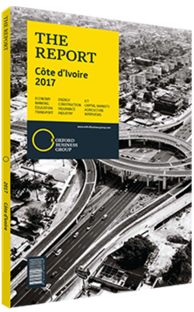Revamping of port facilities in Cote d'Ivoire accelerates
To capitalise on its geographic position, Côte d’Ivoire is investing heavily to revamp and modernise its ageing transport infrastructure. A significant portion of the expansion work is focused on the port of Abidjan, the country’s primary maritime facility and an important source of public revenues. However, with GDP expanding by 8.4% in 2015, the port has also become a victim of the country’s economic rebound, witnessing an increase in congestion that year.
Traffic Centre
The situation is expected to be reversed with an expansion in handling capacity. Despite some delays, work on the construction of a second terminal at the port of Abidjan began in November 2015. The new infrastructure project is expected to cost $2bn, and will more than double handling capacity from 800,000 containers per year to 2m, when it becomes operational in 2018.
The new terminal will be managed under a consortium made up of Bolloré Africa Logistics, the Africa-based subsidiary of the French transport firm Bolloré, and Dutch port operators APM Terminals, which will oversee operations at the new facility for 21 years. “That will evidently improve the port’s capacity, allowing it to absorb higher traffic levels, and help make Abidjan port a redistribution hub in the western African coast,” François Egon, sales and marketing director at Bolloré Africa Logistics, told OBG.
The project also includes the construction of a new minerals terminal, which will be help align the port with the country’s increasing focus on its mineral resources, which include gold, bauxite and manganese.
Work on the facility will be done by Chinese-based contracting firm China Harbour Engineering Group, and the Eximbank of China will finance the project to the tune of $900m. One key component of the expansion scheme will be the enlargement of the Vridi Canal, a narrow and shallow entry point that has limited the access to the port to feeder vessels and ships with a maximum length of 250 metres and a maximum draft of 11.5 metres. Dredging work is set to deepen the seaway from 11.5 metres to 16 metres. Expansion of the Vidri Canal alone will impact port capacity by allowing larger container ships to reach the port.
Infrastructure expansion work is also taking place in the country’s second port of San Pedro. Located in south-west Côte d’Ivoire, the port handles commodities exports, including cocoa, the country’s chief export. The port, managed under a concession agreement by Swiss-Italian firm Mediterranean Shipping Company (MSC) since 2008, has seen its role in the national economy become more relevant, with its share of Ivorian exports rising from 20% to 35% between 2013 and 2015. Total cargo handled at the facility rose from 4.7m tonnes to 4.85m tonnes in 2015. Work on the expansion of the Port of San Pedro was set to begin in the last quarter of 2016.
In September 2016 authorities approved an initial investment of €465m for the project. The expansion work will be done by MSC in conjunction with emirate contractor Bilal Group. Financing for the project will come from different sources. MSC is set to invest €185m in the project, with an additional €280m coming from the Bilal Group.
The state is also expected to contribute €350m worth of public funding to the overall project. Part of the project’s goal is to diversify port activity away from agricultural commodities. Partnering with the National Petroleum Company of Côte d’Ivoire, the Port of San Pedro aims to take advantage of nearby oil and gas exploration and construct a refined fuel terminal with a 50,000-tonne capacity, set to cost CFA30bn (€45m).
Regional Role
This regional scope will be important for the growing role of the country’s ports in West Africa. Although the Port of Abidjan remains one of the region’s biggest facilities, the country’s unrest several years ago allowed competing ports in West Africa, such as the Port of Tema in Ghana and the Port of Dakar in Senegal, to gain a bigger slice of regional traffic.
You have reached the limit of premium articles you can view for free.
Choose from the options below to purchase print or digital editions of our Reports. You can also purchase a website subscription giving you unlimited access to all of our Reports online for 12 months.
If you have already purchased this Report or have a website subscription, please login to continue.

